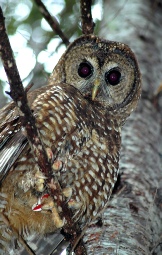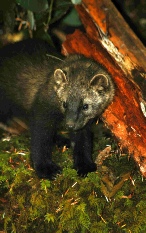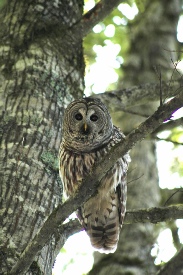

Mission Statement:
Provide for the conservation and development of natural resources for the present and future benefit of the Hoopa Tribe, while protecting Tribal cultural integrity including fish, wildlife, plants and their habitats.
The main goal and purpose of the Tribal Wildlife Department is to ensure that the
wildlife related environmental review and documentation is completed in order to
implement forest management activities such as timber sales, stand improvement, fuel
reduction and prairie restoration projects. This requires surveying for species
protected under the Federal Endangered Species Act (ESA) such as the northern spotted
owl and marbled murrelet. The Wildlife Department began with the hiring of a wildlife
biologist in May 1991 shortly after the northern  spotted owl was listed as a threatened
species. Since that time there have been numerous seasonal technicians hired to
complete the surveys for spotted owls and marbled murrelets (listed as threatened
in 1992). Both the peregrine falcon and bald eagle were on the Endangered Species
list in the 1990’s and both have been recently removed from the list.
spotted owl was listed as a threatened
species. Since that time there have been numerous seasonal technicians hired to
complete the surveys for spotted owls and marbled murrelets (listed as threatened
in 1992). Both the peregrine falcon and bald eagle were on the Endangered Species
list in the 1990’s and both have been recently removed from the list.  In the mean
time the fisher has been classified as a Candidate for protection Under the ESA after
a decade and a half of petitions. The Fish and Wildlife Service will likely make
a decision on whether to list the fisher by sometime in 2014. Over the years the
Wildlife Department has taken on many additional tasks and projects beyond simply
ensuring timber sales can be approved. Most of which has been funded by Federal grants
or add-
In the mean
time the fisher has been classified as a Candidate for protection Under the ESA after
a decade and a half of petitions. The Fish and Wildlife Service will likely make
a decision on whether to list the fisher by sometime in 2014. Over the years the
Wildlife Department has taken on many additional tasks and projects beyond simply
ensuring timber sales can be approved. Most of which has been funded by Federal grants
or add-
Summary of Wildlife Projects
Every year since 1992 the wildlife crew has surveyed the entire reservation (except
the South Tish Tang and Box Camp Reserves) for northern spotted owls. All spotted
owls located are banded with color bands and USFWS number bands. Previously banded
birds are re-
 We have kept track of barred owl responses received during the course of spotted
owl surveys since 1991. Barred owls (an invasive species from the east) have increased
dramatically and as they have increased the spotted owl population has decreased.
In 2009 we started specifically surveying for barred owls in an effort to document
their increase and the apparent impact to the spotted owl population. Since the
threatened spotted owl is declining on the reservation and throughout much of it’s
range it is important that we determine whether the decline at Hoopa is related to
barred owls or timber harvest. We strongly suspect that it is primarily due to barred
owls taking over the landscape.
We have kept track of barred owl responses received during the course of spotted
owl surveys since 1991. Barred owls (an invasive species from the east) have increased
dramatically and as they have increased the spotted owl population has decreased.
In 2009 we started specifically surveying for barred owls in an effort to document
their increase and the apparent impact to the spotted owl population. Since the
threatened spotted owl is declining on the reservation and throughout much of it’s
range it is important that we determine whether the decline at Hoopa is related to
barred owls or timber harvest. We strongly suspect that it is primarily due to barred
owls taking over the landscape.
We have also been conducting research on fishers intensively since 2005 after first beginning studies in 1992. So why study fishers? Fishers are a Candidate for Federal protection under the ESA and also have cultural value. Therefore, if they become listed the tribe would benefit from having as much biological data as possible. Our study is the single largest study of fishers in western North America in number of animals and years of study. There are 2 studies in the southern Sierra Nevada’s which are comparable but they have not been going as long as Hoopa. We have partnered with the Wildlife Conservation Society (WCS) and Integral Ecology Research Center (IERC) in our fisher research efforts.
We documented a 75% reduction in fisher density between 1998 and 2005 but do not know what caused the decline. Since 2005 the population seems to have stabilized and may be increasing slowly. Part of our research effort has been to estimate survival rates and determine the causes of mortality. We have monitored 92 individual fishers (58F, 34M) with the use of radio telemetry and documented 44 mortalities (29F, 15M). Nineteen of the 29 females died from predation, primarily from bobcats while 5 of the 15 male mortalities were from predation (all mountain lions). Predators have been confirmed using a forensic protocol and molecular techniques (DNA) to confirm predators. Predation has been by far the number one source of mortality (73% of all known causes 24/33 with 11 unknown causes of mortality). Predation appears to be a very significant factor in regulating fisher populations in California. One very disturbing finding across all the California fisher studies is that Anticoagulant Rodenticide (AR) poisons have been found in a high percentage of animals that have been tested (70+%) and have been confirmed to cause mortalities at Hoopa and the S. Sierras. Most of the AR poisoning has been attributed to illegal marijuana growing but some could also be the result of legal use at residences.
Because predation has been such an important cause of mortality for female fishers and bobcats have been the most frequent predator, we have expanded our fisher project to include a bobcat component. We currently are monitoring 3 male bobcats with the use of GPS collars. We have also collected substantial data on 4 other cats which have all died during the last year. Three female bobcats were monitored and have died. One was killed by a predator (most likely a coyote), one died from an extreme internal parasite load (nematodes in lungs and digestive system) and one we suspect was hit by a car. One 10 year old male cat died of unknown cause. The cats with GPS collars have provided us approximately 2500 point locations which will be used to estimate habitat use and selection across the landscape and to identify habitat conditions that may increase fisher risk of predation. The majority of the fisher and bobcat work has been funded by Federal grants.
We have also been working with black bears off and on since 1998. Black bears cause tremendous damage to conifer plantations and we have been searching for solutions to control or reduce that problem. Bottom line is they eat fast growing young trees in the spring when other food is in low supply. Some years damage levels are very high and in others relatively low. Low damage years appear to correspond with the abundance of acorns held over from the previous fall. High acorn frequency in spring bear scats equals low damage years. The tree damaging behavior is pretty clearly learned from mother to off spring but may also be learned from other bears. Females tend to do more damage than males. We have not had any funding to work with bears for several years now and have simply been monitoring annual damage levels and trying to determine which silvicultural treatments result in the best future stand conditions in terms of conifer volume. Bears are eating machines and are relatively intelligent. Once they learn about a food source they will likely return. Therefore, it is best to keep bears from getting a free meal around homes because once they do they most likely will return.
We have just begun a new pilot project studying pileated woodpeckers. The project will contribute to Dawn McCovey’s masters thesis. We are still trying to obtain grant funding to help with the costs. Dawn has won a National Science Foundation Fellowship to cover her living expenses while working on the project and attending school. The study will focus on habitat selection at the home range scale but will also allow us to investigate roost and nest site selection and help us to evaluate how well the forest management plan is doing in terms of maintaining critical habitat elements for this cultural icon.
